During Michael’s distinguished 45-year career in law enforcement as one of the world’s most experienced forensic artists, he has consulted on several cases that have made international headlines.
Below are some examples of his most high-profile cases, where he had the honor and privilege of assisting law enforcement investigators.
Michael believes that all victims’ stories should be told. Since he’s consistently asked about the following true crime cases, he expanded the stories behind the sketches for your reading enjoyment.
To see more captures, please visit the Captured Galleries.
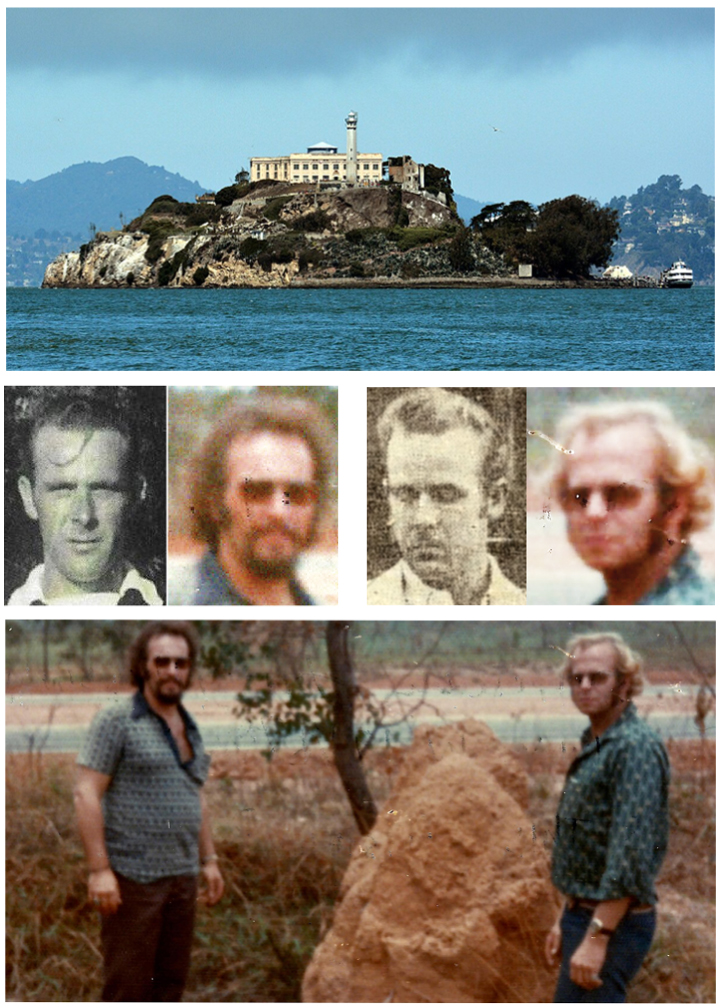
Background
The 1962 escape from Alcatraz is one of American history’s most famous prison breaks. On the night of June 11, 1962, three inmates—Frank Morris and brothers John and Clarence Anglin—escaped from the maximum-security federal penitentiary on Alcatraz Island, located in San Francisco Bay.
‘The Rock’
Alcatraz was considered an inescapable prison due to its isolated location, cold waters, and strong currents. However, Morris, who was highly intelligent and had a history of successful escapes, and the Anglin brothers, who were also experienced escapees, devised an elaborate plan over several months.
The Plan
The trio secretly worked to enlarge the ventilation ducts in their cells, using improvised tools such as spoons, pieces of metal, and a drill made from a vacuum cleaner motor. They covered the holes with cardboard and painted them to match the walls. Behind the ducts, they created a secret corridor to store tools and work without being detected.
To leave their cells undetected, they created dummy heads from a mixture of soap, toilet paper, and natural human hair, which they placed in their beds to fool the guards during night headcounts. The escapees also crafted makeshift life vests and a raft out of raincoats.
The Escape
On the night of the escape, Morris and the Anglin brothers squeezed through the holes in their cells, climbed up a utility corridor, and made their way to the prison’s roof. They then descended the outer wall and reached the shoreline, where they inflated their raft and disappeared into the frigid waters of San Francisco Bay.
The Hunt
The following day, the escape was discovered when guards found the dummies in their beds. A massive manhunt ensued, but the escapees were never found. The FBI declared them missing and presumed drowned. Still, over the years, evidence and rumors have surfaced suggesting they may have survived.
The case remains one of the most intriguing mysteries in criminal history. The FBI officially closed the case in 1979, concluding that the men had unlikely survived the cold waters and strong currents. However, in the decades since, numerous theories and alleged sightings have kept the story alive, leaving the question of whether they made it to freedom unresolved.
The Photo
In 2015, I was contacted by a production company filming a documentary about the escape.
In the years since the escape, alleged photos of the Anglin Brothers surfaced, calling into question the F.B.I.’s assertion that the three escapees drowned during their escape attempt.
The production crew asked that I compare the photographs against known photos of Charles and Clarence Anglin to verify the authenticity of the unknown photograph.
I examined the photo depicting two male subjects standing together. While I couldn’t verify the authenticity of the image, I was able to render an opinion that it was highly likely that the subjects depicted in the question photo were Charles and Clarence Anglin.
The documentary and my evaluation of the photo sparked a search in South America, where it was thought the brothers fled.
Though they have not been found, there is compelling evidence that they successfully escaped “The Rock”.” Where they went from there and whether Frank Morris escaped is anyone’s guess.
It was a fascinating case and a significant piece of American History that I was glad to be a part of.
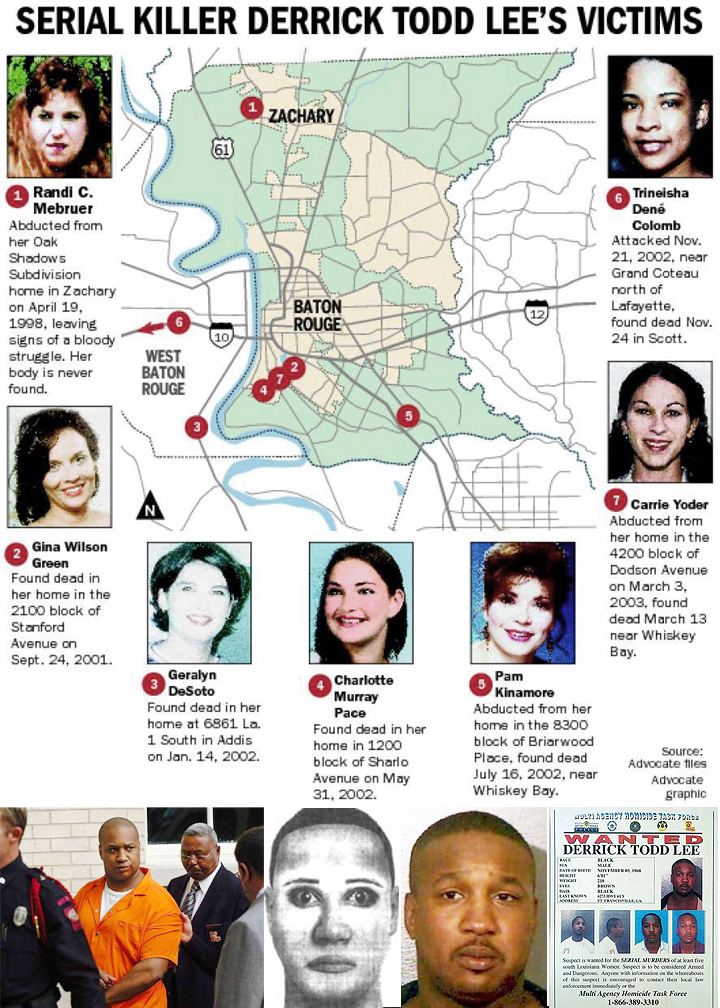
Synopsis
The Baton Rouge Serial Killer references a series of murders that took place in Baton Rouge, Louisiana, from 1992 through 2003. This was an unusual case involving two serial killers operating simultaneously in the same area. The murders were first thought to be the work of a single serial killer. This led to a long and complex investigation before the killers were finally identified and arrested.
The Killers
Derrick Todd Lee was the most infamous of the Baton Rouge serial killers. He was responsible for what authorities believe to be the murders of seven in the Baton Rouge area between 1998 and 2003. Lee’s targets were typically young, attractive women. His attacks often occurred inside their homes, where Lee would brutally beat, stab, or strangle them to death.
Thanks to DNA evidence, Lee was identified and apprehended in 2003, ending his reign of terror. He was later convicted of two murders and sentenced to death. Lee died from natural causes in 2016 while on death row.
Sean Vincent Gillis was roaming the Baton Rouge around the same time as Lee. Gillis was active between 1994 to 2003, during which time he was suspected of murdering eight women. His crimes included sexual assault, mutilation, and post-mortem desecration of their bodies.
Gillis was identified and arrested in 2004 as the result of DNA evidence he left at several crime scenes. He was convicted and sentenced to life in prison without the possibility of parole.
Zachary, LA Connection
At the time of the murders, Derrick Todd Lee was well known by officers of the Zachary, LA Police Department. Lee was a prolific ‘peeping Tom’ and was the suspect in the 1992 murder of Connie Warner and the 1998 disappearance of Randi Mebruer. Both women lived in the same neighborhood in Zachary. Mebruer’s body has never been found.
In 1998, I worked with a company that had developed a new facial composite software application. The Fox Television program “America’s Most Wanted” promoted it, and I was hired to road-test it in several cases.
One of those cases was a deadly assault that occurred in Zachary. A young couple was accosted by a machete-wielding suspect during a rainy night in a local cemetery where the couple were talking inside their unlocked vehicle. Without warning, the suspect opened the car door and began swinging the machete in his attempt to harm them.
The female victim sat with me and described a wild-eyed individual with bloodshot eyes. I produced a composite sketch of the suspect, who Zachary officers recognized as Derrick Todd Lee. Information was passed along to a local task force. It wasn’t until several months later that Lee was identified due to his DNA.
There was a lot of confusion and fear within the community. Some mistakes were made by law enforcement compounded by some who were involved with the case who were less than cooperative.
The crimes committed by Derrick Todd Lee and Sean Vincent Gillis were particularly vexing for law enforcement, who at the time didn’t have the technology we have today to organize, analyze, and link cases, which could have resulted in the cases being solved more quickly.
Either way, the terror that Lee and Gillis created will be remembered as some of the most disturbing and notorious serial killings in Louisiana’s history.
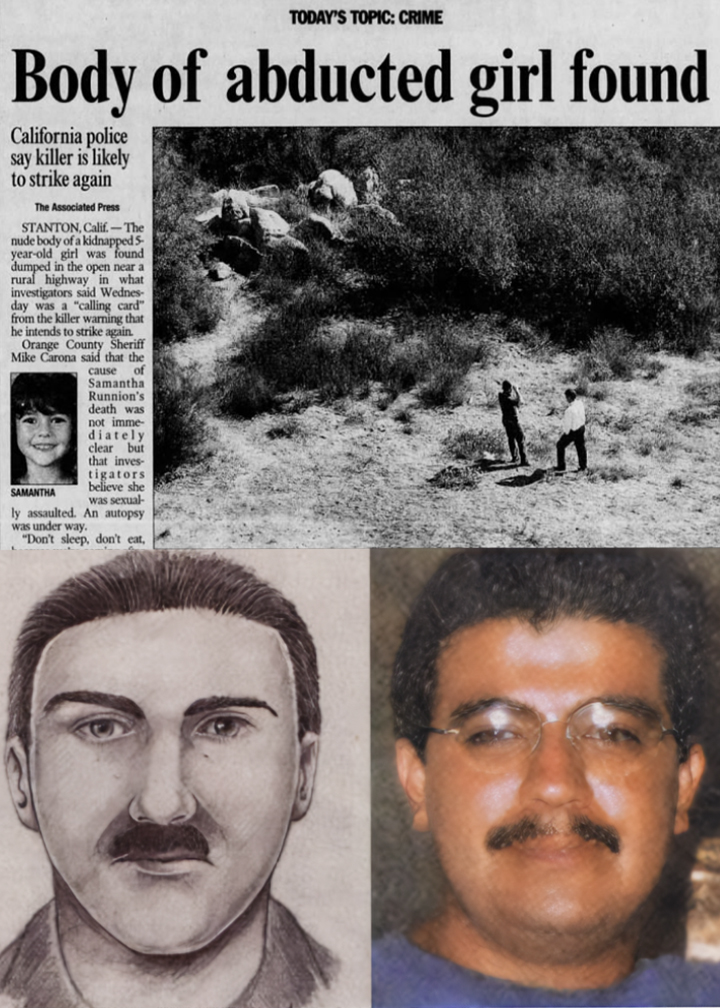
In July 2002, Samantha Runnion, a five-year-old girl, was abducted by a stranger and later found murdered in Southern California. Her case was one of many high-profile abductions that occurred that year, highlighting the dangers that children face when enjoying public spaces.
Abduction
On July 15, 2002, Samantha played with a friend near her home in Stanton, California. A man approached the girls and asked if they had seen his lost dog. He grabbed Samantha and fled the scene in his vehicle parked nearby. Her friend ran to get help, but the man had already fled. Her friend witnessed the abduction and provided a description of the man and the vehicle.
Investigators later asked me to meet with their eyewitness, who was also five years old, to create a composite sketch of Samantha’s abductor. After working together for several hours, we produced a sketch she was satisfied with.
Discovery of her body
The day after her abduction, Samantha’s body was found about 50 miles away in a remote area of Riverside County. She had been sexually assaulted and suffocated. The brutality of the crime shocked the nation and intensified the search for her killer.
Investigation and Arrest
Witnesses recognized the person in the sketch as Alejandro Avila, a 27-year-old Lake Elsinore, California factory worker. One year earlier, Avila was acquitted by a Riverside County jury who found him not guilty of molesting two teenage girls.
They reported their suspicions to sheriff’s investigators, who detained Avila. Investigators compared his DNA with that found on Samantha and inside his vehicle. Other forensic evidence was found during a search of his home, linking him to Samantha’s murder. Avila was arrested on July 20, 2002.
Trial and Conviction
Prosecutors charged Alejandro Avila with kidnapping, sexual assault, and murder. He was tried, convicted, and sentenced to death in 2005 by a jury who reviewed overwhelming evidence of his guilt. Avila remains on death row as his case winds through the appeals process.
Aftermath and Legacy
Samantha Runnion’s murder had a profound impact on the nation. It led to increased public awareness about child abductions and the implementation of more robust Amber Alert systems in various states. Her mother, Erin Runnion, became an advocate for child safety, founding the Joyful Child Foundation, which works to prevent child exploitation and abduction through education and community programs.
Samantha’s case remains a tragic reminder of the dangers that children can face and the importance of vigilance in protecting them.
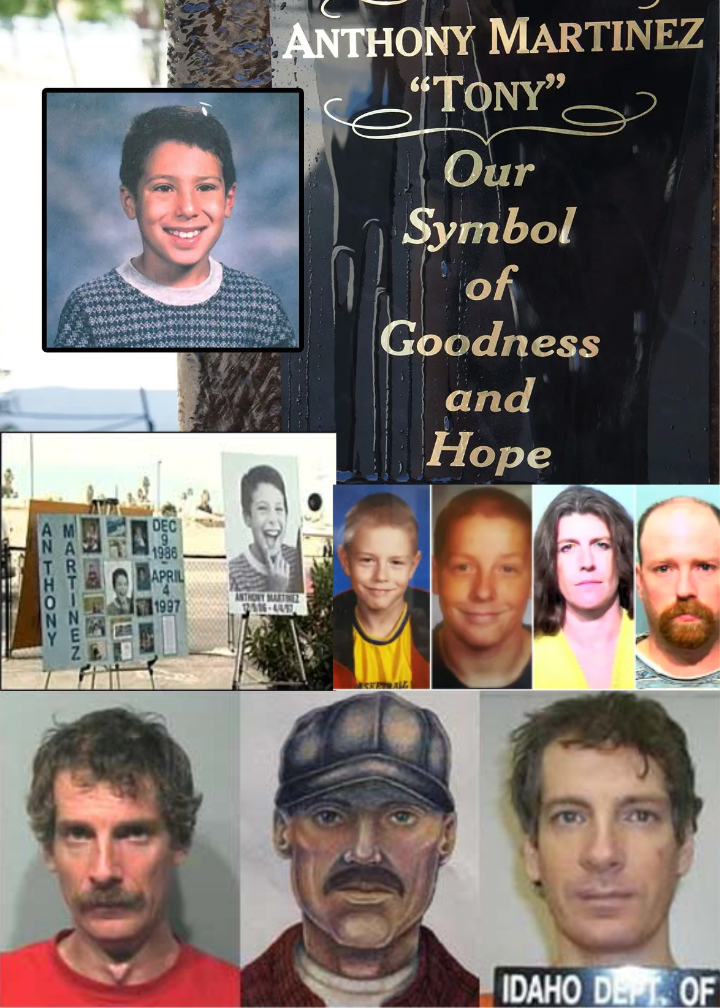
In April 1997, Anthony Martinez, a 10-year-old boy, was abducted and brutally murdered in Beaumont, California. His case is one of the most tragic and memorable in Southern California’s history due to the circumstances surrounding his death and the long journey to justice.
Abduction
On April 4, 1997, Anthony played with his younger brother and a friend near their home in Beaumont. A man approached the boys, asking for help finding his lost cat, a ploy used in many stranger abductions. The man then pulled out a knife, grabbed Anthony, and forced him into his car before fleeing the scene. Despite an intense search mounted by law enforcement, they were unable to locate Anthony or his abductor.
The next day, I was summoned to Beaumont by detectives who asked that I interview Anthony’s brother and friend to create a composite sketch of the kidnapper. After a couple of hours, we were able to finish a sketch that they believed to be a close likeness of Anthony’s kidnapper.
Discovery of the Body
Twelve days after Anthony was kidnapped, his body was located in a remote desert area near Indio, California, approximately 70 miles from where he was taken. Investigators determined that the kidnapper had attempted to conceal his body under a pile of rocks. Upon closer examination of the body, investigators determined that he was sexually assaulted before he was murdered.
Investigation and Breakthrough
After months of investigation, Anthony’s case went cold. In 2005, Joseph Edward Duncan III, a serial killer and pedophile, was arrested for the kidnapping and murder of members of the Groene family in Idaho.
During an interview with detectives, Duncan confessed to Anthony’s abduction and murder. He provided detectives with details that only the killer would know. Duncan admitted that he had been driving through Beaumont when he randomly targeted Anthony. Investigators compared my sketch with Duncan’s arrest photo, which helped corroborate his statement.
Trial and Sentencing
Joseph Duncan faced the death penalty for his Idaho crimes when he was linked to Anthony’s murder. California prosecutors felt that his federal death sentence all but assured his sentence would be carried out. Duncan’s confession and the DNA evidence gave the Martinez family the closure they had long hoped for.
Aftermath
Anthony Martinez’s murder had a lasting impact on his family and the community. His parents became advocates for missing and exploited children, helping to raise awareness about child safety. The case also highlighted the importance of DNA technology in solving cold cases. It brought attention to the need for more stringent monitoring of repeat offenders like Duncan.
The tragic story of Anthony Martinez is remembered as a heart-wrenching example of the random and senseless violence that can strike innocent children. His case continues to serve as a reminder of the importance of vigilance and the need for justice in protecting the most vulnerable members of society.

Background
On April 21st, 2005, Ha ‘Jade’ Smith and her adult daughter, Anita Vo, were found stabbed to death inside Smith’s home, located in the Little Saigon area of Westminster, CA.
Police determined several valuable items, including cash, jewelry, and credit cards, were stolen from the home.
Crime Scene
During their examination of the crime scene, investigators noticed that both victims’ hands were bathed in white paint. They learned that Smith was a famous, well-known fortune teller in the Vietnamese community.
This led investigators to believe that there might have been an occult-type ritual regarding the victim’s hands being painted white or that there was a cultural connection as the Vietnamese associate white with death.
Eyewitness
Westminster Police detectives called me to assist with interviewing an eyewitness who saw Nelson and Zamora exit and enter the property by crawling through a partially open garage door. She sat inside her parked vehicle, watching them in the side view mirror a few yards away.
Suspects
Police later identified the suspects as Tanya Nelson, a former client of Smith and Phillipe Zamora, whose wife was also one of Smith’s clients.
The following month, investigators were alerted to activity on Smith’s credit cards. Nelson purchased plane tickets for a trip to Orange County, CA, where she planned a shopping spree using Smith’s credit cards. Investigators arrested her at a hotel in Costa Mesa, CA. Zamora was arrested in North Carolina.
Possible Motives
Although police never learned the reason for the white paint, there were two prevailing theories about why the murders were committed.
The first is a reading that Smith provided did not work out as described during a fortune-telling session. The other is greed.
Nelson knew that Smith had several pieces of expensive jewelry and that she kept several thousand dollars of cash on hand. A 2001 home invasion at Smith’s residence yielded a nearly $300,000 loss in cash and other valuables.
Zamora’s only reason for following along was Nelson’s promise that she would connect him with gay sex partners when they reached Orange County.
Judgement Day
Both Nelson and Zamora were found guilty of the murders. Nelson was sentenced to death, while Zamora was sentenced to 27 years in prison.
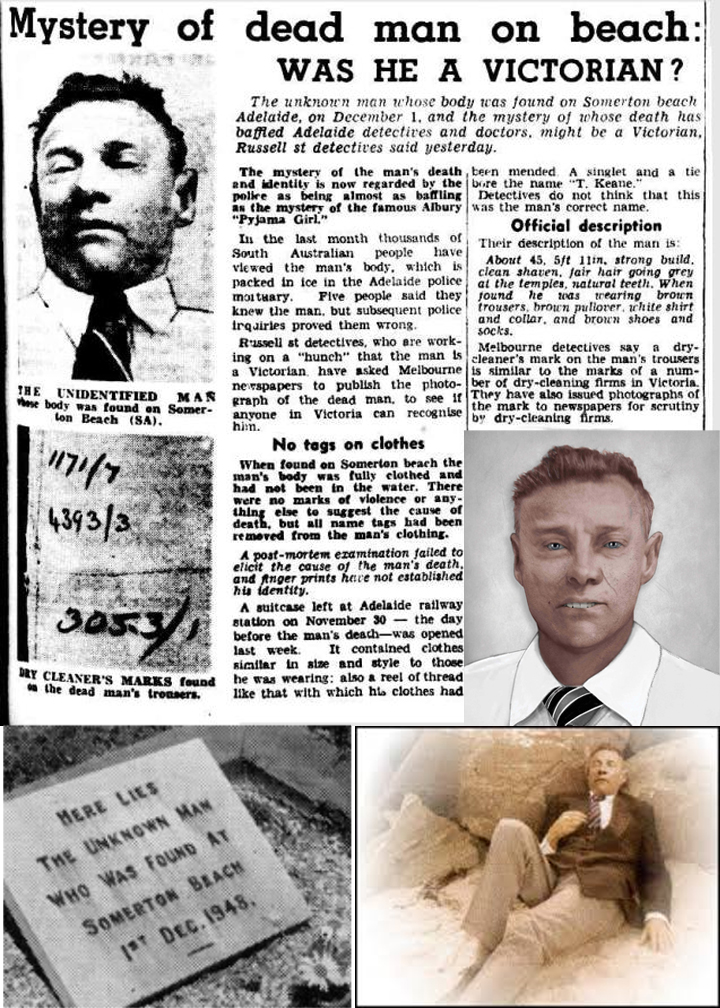
On December 1, 1948, an unidentified man was found dead on Somerton Beach, close to Adelaide, South Australia. When attempts to identify him failed, he was given the nickname – The “Somerton Man.” Because of the unusual circumstances surrounding his death and the lack of identification, the case became one of Australia’s most enduring mysteries.
Discovery
The “Somerton Man” was discovered lying on the sand, propped up against a seawall, dressed in a suit and tie. Mysteriously, all the labels on his clothing had been removed, and he had no identification. An exhaustive investigation failed to reveal clues to his identity. An autopsy was conducted for further clues. However, there was no evidence or conclusive cause of death. No signs of violence were present, and an autopsy failed to conclusively reveal a cause of death. Although some suggested the possibility he was poisoned, that theory could not be proven.
The Mystery Deepens
Most puzzling was a piece of paper found in a hidden pocket of his pants. On the paper were the words “Tamám Shud,” meaning “ended” or “finished” in the Persian language. This phrase was included on the final page of a rare book of Persian poetry titled Rubaiyat of Omar Khayyam. A copy of this book, with the final page torn out, was found inside a car close to the beach, further adding to the mystery of “The Somerton Man.”
The Code
The page contained a series of seemingly random letters, thought to be a code. Cryptographers and amateur sleuths made several unsuccessful attempts to unravel the mystery, making the code seem unbreakable. Investigators did notice a phone number written inside the book that led them to “Jestyn,” a local nurse. She denied knowing the man and appeared bothered when she saw his photo. Authorities kept her identity anonymous for several years. While some felt this furthered the mystery, it could have been for no other reason than to protect her privacy.
Identified
Advances in DNA technology have helped police solve many cold case mysteries. The Somerton Man was no exception. In 2022, researchers announced that they used forensic genealogy techniques to construct a DNA profile using a sample of Somerton’s hair. The results of their research identified The Somerton Man as Carl “Charles” Webb. an electrical engineer and instrument maker from Melbourne.
Identifying Webb was important because knowing his identity, where he was from, and his profession could lead investigators to important clues about why he was in Adelaide and what might have caused his death. In this case, it didn’t help, and these important aspects of the case remain unresolved.
The Somerton Man, aka Carl Webb’s case, continues to captivate the public. It has inspired numerous theories, books, documentaries, and ongoing investigations, remaining one of modern history’s most intriguing unsolved mysteries.

